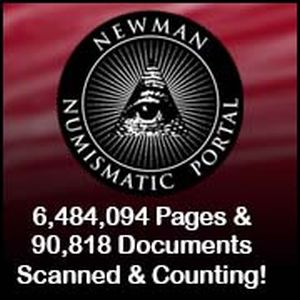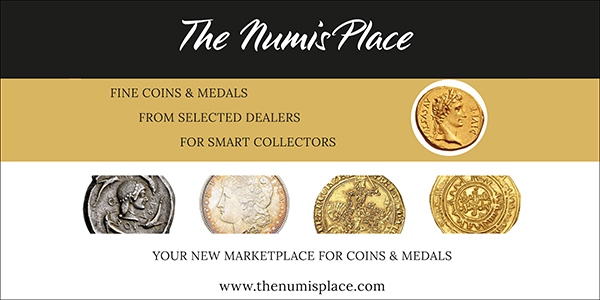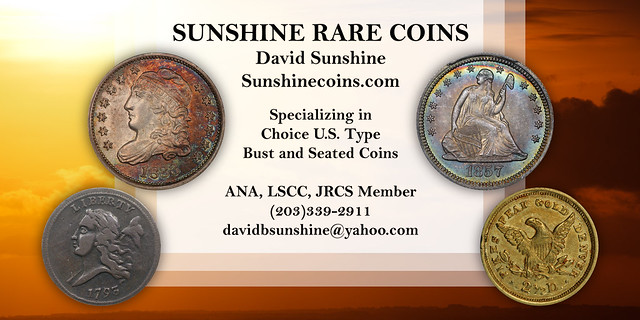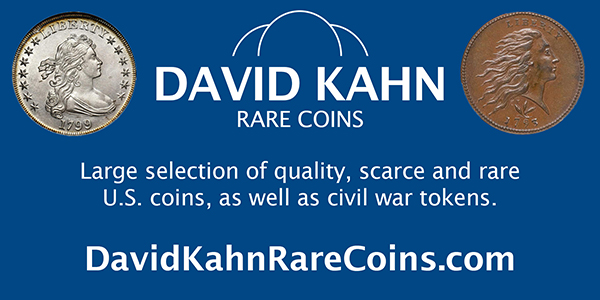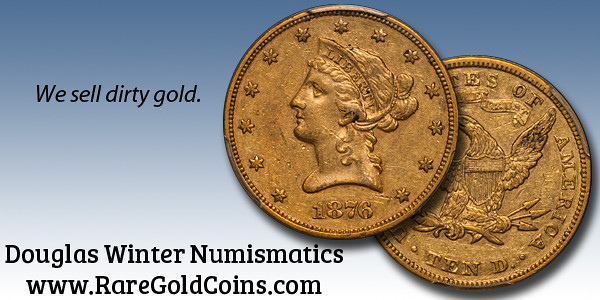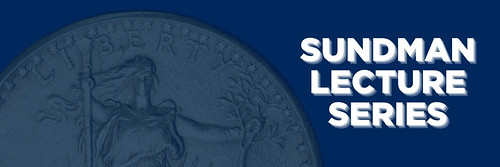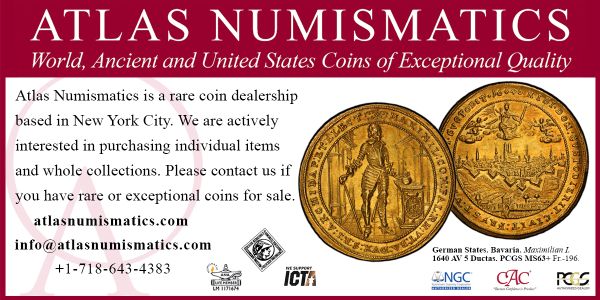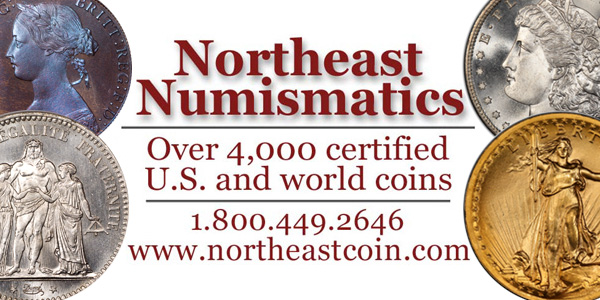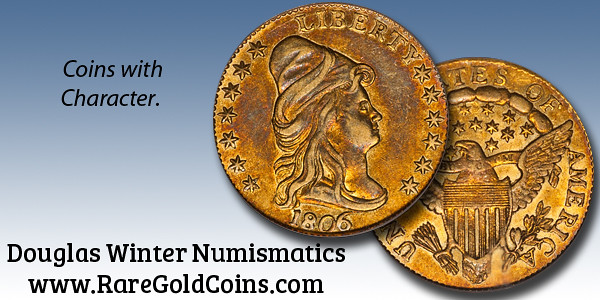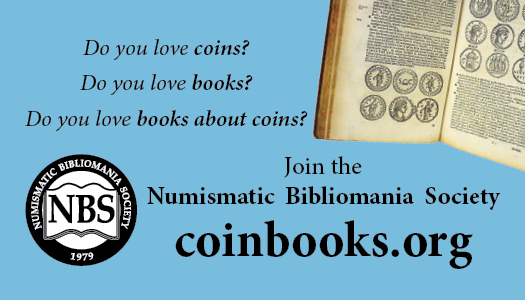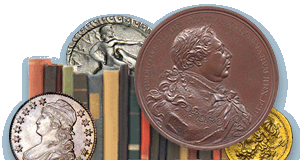
Visit our NBS Sponsors


About UsThe Numismatic Bibliomania Society is a non-profit association devoted to the study and enjoyment of numismatic literature. For more information please see our web site at coinbooks.org SubscriptionsThose wishing to become new E-Sylum subscribers (or wishing to Unsubscribe) can go to the following web page link MembershipThere is a membership application available on the web site Membership Application To join, print the application and return it with your check to the address printed on the application. Print/Digital membership is $40 to addresses in the U.S., and $60 elsewhere. A digital-only membership is available for $25. For those without web access, write to: Jeff Dickerson, Treasurer AsylumFor Asylum mailing address changes and other membership questions, contact Jeff at this email address: treasurer@coinbooks.org SubmissionsTo submit items for publication in The E-Sylum, write to the Editor at this address: whomren@gmail.com BUY THE BOOK BEFORE THE COINSale Calendar
|
- WAYNE'S WORDS: THE E-SYLUM JUNE 8, 2025
- NEW BOOK: U.S. TRADE DOLLAR
- NEW BOOK: HISTORY OF HUNDIS USED IN INDIA
- NEW BOOK: TABLES OF POLISH BANKNOTES
- NEWMAN PORTAL ADDS FUN CONVENTION VIDEO
- VIDEO: PEOPLE, COINS AND CATALOGUES
- MORE ON THE PIONEER BASE BALL CLUB
- NOTES FROM E-SYLUM READERS: JUNE 8, 2025
- ANS ALFRED S. ROBINSON DIE GROUP
- FRED HOLABIRD ANNOUNCES RETIREMENT
- NOAL WHITE NAMED CHERRYPICKERS CO-EDITOR
- SUNDMAN LECTURES: COINS REFLECT CULTURE
- VOCABULARY TERM: REVISION
- JOHN SMITH GARDNER (FL. 1794-1796)
- SETH G. HUNTINGTON (1920-2021)
- TREASURE TALK WITH BOB EVANS, EPISODE 5.2
- NUMISMAGRAM MEDAL SELECTIONS: JUNE 8, 2025
- SOVEREIGN RARITIES AUCTION XVIII
- SARC ACCUMULATIONS & COLLECTIONS AUCTION 2
- HERITAGE: PEH FAMILY COLLECTION
- WAYNE'S NUMISMATIC DIARY: JUNE 1, 2025, PART THREE
- HERITAGE: THE PANIC OF 1837
- TURKS AND CAICOS ISLANDS ONE POUND NOTE
- PANAMA-PACIFIC COIN SET LETTERS
- PHYSICAL CRYPTO AT BITCOIN 2025 CONFERENCE
- LOOSE CHANGE: JUNE 8, 2025
- ABOUT THIS ISSUE: JUNE 8, 2025
Content presented in The E-Sylum is not necessarily researched or independently fact-checked, and views expressed do not necessarily represent those of the Numismatic Bibliomania Society.
WAYNE'S WORDS: THE E-SYLUM JUNE 8, 2025
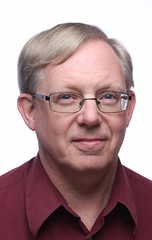 New subscribers this week include:
Clark Davis.
Welcome aboard! We now have 7,231 subscribers.
New subscribers this week include:
Clark Davis.
Welcome aboard! We now have 7,231 subscribers.
Thank you for reading The E-Sylum. If you enjoy it, please send me the email addresses of friends you think may enjoy it as well and I'll send them a subscription. Contact me at whomren@gmail.com anytime regarding your subscription, or questions, comments or suggestions about our content.
This week we open with three new books, updates from the Newman Numismatic Portal and the American Numismatic Society, notes from readers, and more.
Other topics this week include trade dollar varieties, Hundis used in India, the FUN and PAN shows, the Cherrypickers' Guide, Alfred S. Robinson, Fred Holabird, Seth Huntington, the Sundman lectures, fixed price and auction selections, the SS Central America, the Panic of 1837, and physical cryptocurrency.
To learn more about varieties of Polish banknotes, the Art Directors Club medal, the 1860 Fireman's Medal, the Coin Collecting Podcast, the Gold Bar Mine, the Art of American Coinage, "coin fossils", the Dorrien Magens shilling, the Peh Family Collection, whale oil, and spending eight bitcoins on a pizza, read on. Have a great week, everyone!
Wayne Homren
Editor, The E-Sylum
NEW BOOK: U.S. TRADE DOLLAR
In the June 2025 edition of E-Gobrecht from the Liberty Seated Collectors Club, LSCC President Len Augsburger reviews a new book on U.S. Trade Dollar varieties. We're republishing it here with permission. Thanks! -Editor
Joe Kirchgessner Publishes U.S. Trade Dollar: Rarity, Collection Types and Top 37 Varieties
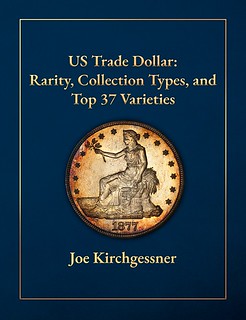 Among Liberty Seated denominations, the Trade dollar has heretofore lacked a comprehensive
guide to the die varieties in that series. With the publication of Joe Kirchgessner's U.S. Trade Dollar,
that problem has been solved, and collectors looking to explore the world of Trade dollar die
marriages now have a well-defined starting point.
Among Liberty Seated denominations, the Trade dollar has heretofore lacked a comprehensive
guide to the die varieties in that series. With the publication of Joe Kirchgessner's U.S. Trade Dollar,
that problem has been solved, and collectors looking to explore the world of Trade dollar die
marriages now have a well-defined starting point.
This 522-page compendium contains just about everything collectors need to know, with the strengths of the book being the Top 37 varieties (I'm not sure why it wasn't the "Top 25" or "Top 50" – perhaps Kirchgessner likes the fact that the number 37 has some interesting mathematical properties) and the lengthy enumeration of obverse and reverse dies for each issue.
For these chapters, Kirchgessner has adapted the variety attribution template from Bill Bugert's "Register" volumes on Liberty Seated halves, making the layout appear immediately familiar and straightforward to use. The large format (8.5x11) and photographic enlargements make attribution a snap, with ample arrows highlighting the pickup points.
NEW BOOK: HISTORY OF HUNDIS USED IN INDIA
Anil Bohora has published a new book going beyond cataloging and into the history of the Hundis scrip notes of India. Congratulations! For background, here is an excerpt from the book's Introduction and first chapter. -Editor
This book provides a detailed history and usage of Hundis, which were a form of scrip used in India for quite a long time.
 One early seventeenth-century French traveler to India, Mr. J. B. Tavernier, writes:
One early seventeenth-century French traveler to India, Mr. J. B. Tavernier, writes:
In this country when anyone wishes to transfer money to a distant place, without undertaking the risk of journey and expenses of conveyance, he delivers the money to a financier. The latter gives him a written paper, which is drawn on the place desired; and there the drawee hands over the money upon sight of that handwritten paper. That document they all know by the name Hundi.
While collecting and researching Hundis, it becomes very clear that Indian bankers were using a variety of innovative financial and credit instruments to facilitate trade and the movement of large sums of money across the subcontinent in a most secure and efficient manner, hundreds of years before the Western banking system.
NEW BOOK: TABLES OF POLISH BANKNOTES
Here's Google-translated article from Geldscheine Online about a new book listing varieties of Polish banknotes. -Editor
 Janusz Parchimowicz:
Janusz Parchimowicz:
TABLE SERII BANKNOTÓW POLSKICH OD 1944
Tables of Poland's banknote series from 1944
- 60 pages, each note shown in color,
- Format 10 x 15 cm, staple binding,
- 1st edition, Stettin 2025,
- Price 30 zloty (approx. 7 €)
- ISBN No. 978-83-87355-10-4
For several years now, the JEFRYT publishing house has occasionally published miniature editions of coin catalogs in addition to the main catalog, measuring 9 x 12 cm and featuring varying content. A similar booklet for banknotes has now been published by the publisher. However, this book, which costs 40 zloty, is not a miniature of the complete catalog, but rather a table of Polish banknotes in circulation from 1944 onwards. It is divided into three parts: the People's Republic of Poland from 1944 to 1965, banknotes from 1974 to 1994, and the most recent banknotes from 1994 onwards.
NEWMAN PORTAL ADDS FUN CONVENTION VIDEO
The latest additions to the Newman Numismatic Portal are videos from the January 2025 FUN show. Project Coordinator Len Augsburger provided the following report. -Editor
Newman Portal Adds FUN Convention Video
The Florida United Numismatists (FUN) winter and summer conventions are two of the most prominent events on the annual coin calendar, with the winter edition being especially attractive to collectors seeking warmer climes. Indeed, FUN describes itself as a "snow-free coin show." With the assistance of FUN board member Steve Martin, Newman Portal has added 12 videos representing educational presentations from the January 2025 convention. Included are David Harper, former Numismatic News editor, presenting his "Ten Numismatic Predictions for 2025." Harper reviews his performance on last year's predictions (a rare bit of accountability in today's world!) and issues a new set of prognostications for 2025. Among other sessions are Tom Walker speaking on the detection of cleaned coins, Bill Jones holding forth on early Lincoln cents, and John Zampedro presenting on "Errors 101." Many thanks to Randy Campbell for continuing to organize the FUN convention educational forums.
VIDEO: PEOPLE, COINS AND CATALOGUES
The David Lisot Video Library on the Newman Numismatic Portal can be found at:
https://nnp.wustl.edu/library/multimediadetail/522852
We highlight one of his videos each week in The E-Sylum. Here's one from 2009 with P. Scott Rubin speaking about coin people and catalogues. -Editor
MORE ON THE PIONEER BASE BALL CLUB
Last week we mentioned the Pioneer Baseball Club piece by John Adams Bolen. "The dies for this issue were cut in 1861, commissioned of Bolen by Charles E. Vinton, a hotel clerk at Massasoit House in Springfield, and an associate with the Pioneer Baseball Club in that city." An example in copper is offered in the upcoming Stack's Bowers sale of Bolen medals.
Steve Feller has this to add. -Editor
The more common metal for the token is "white metal." Here is an example:
NOTES FROM E-SYLUM READERS: JUNE 8, 2025
Pittsburgh Travel Guide
Larry Dziubek writes:
"After reading your week in Pittsburgh I think you have a second career in writing travel brochures. You could make a flat tire on a rainy day sound like fun."
Thanks. Last week in Pittsburgh was definitely rainy, but also fun. If you missed my diary articles, they're linked below, and I have a new one elsewhere in this issue.
Actually, a couple weeks ago really I did have a flat tire in the rain on my way to work, waiting about an hour on the Capitol Beltway for a tow truck to arrive and haul my car and I down Whiskey Bottom Road in Maryland to a dealership. It wasn't fun. But I learned just now that the road is "in an area that was first settled by English colonists in the mid-1600s [and] was named in the 1880s in association with one of its residents delivering whiskey after a prohibition vote. See https://en.wikipedia.org/wiki/Whiskey_Bottom_Road . -Editor
To read the earlier E-Sylum articles, see:
WAYNE'S NUMISMATIC DIARY: JUNE 1, 2025, PART ONE
(https://www.coinbooks.org/v28/esylum_v28n22a17.html)
WAYNE'S NUMISMATIC DIARY: JUNE 1, 2025, PART TWO
(https://www.coinbooks.org/v28/esylum_v28n22a18.html)
Other topics this week include cardboard scrip, the Art Directors Club medal, and Coin Collecting Podcast. -Editor
ANS ALFRED S. ROBINSON DIE GROUP
In a recent American Numismatic Society Pocket Change blog article, Jesse Kraft discusses new information concerning a group of dies of the coins, medals and tokens issued by Alfred S. Robinson in the 1860s. -Editor
 With many thanks, a recent archival donation given by Roman Golebiowski helped answer several questions regarding a long-held donation of medallic dies from the 1860s in the ANS collection. A two-sided handwritten letter dated May 23, 1896 from Frank DeWette Andrews to Bauman L. Belden—at the time, the ANS librarian who later became the secretary, council member, and director—provides insight into how the ANS acquired the dies and even into the finished pieces themselves.
With many thanks, a recent archival donation given by Roman Golebiowski helped answer several questions regarding a long-held donation of medallic dies from the 1860s in the ANS collection. A two-sided handwritten letter dated May 23, 1896 from Frank DeWette Andrews to Bauman L. Belden—at the time, the ANS librarian who later became the secretary, council member, and director—provides insight into how the ANS acquired the dies and even into the finished pieces themselves.
According to the accession books in the ANS Archives, the 12 dies were officially accepted into the collection on June 11, 1896, and given the accession group number of 1896.29. This is significant because the dies have long since been divorced from one another. The obverse and reverses were not only separated, but all of the dies were scattered in the die cabinet unattributed. Once digitization of the ANS collection began in the early 1980s, the dies were given numbers from the 0000.999 accession group—indicating that their accession history was unknown by that point—and they were not given consecutive numbers—indicating that their relation to one another was also lost. The recently donated letter allows us to reattribute them to the same donation from June 1896. The medals have now been reassigned with their proper numbers.
FRED HOLABIRD ANNOUNCES RETIREMENT
On Wednesday June 4th, Fred Holabird announced his retirement with this email blast to clients. As he notes, his career has been a "helluva run," touching not only numismatics but countless collectible fields including artifacts salvaged from the wreck of the SS Central America and the archives of the Medallic Art Company. -Editor
I was talking with my buddies yesterday and reminiscing about our running days. The hundreds (or more) long, unforgettable runs through the Sierra Nevada trails, the races – Western States 100, Silver State 50-miler, and all those marathons, including Boston 5 times. Now we're all much older, but still out there in our 70s and 80s doing our stuff together. It was a helluva run. Age and injuries caught up to us… but it was, truly, a helluva run.
Today, another "helluva run" is coming to an end.
It is time for me to retire while I still have some gas in the tank and hopefully the wheels can stay on.
NOAL WHITE NAMED CHERRYPICKERS CO-EDITOR
Whitman has named Noal White as Co-Editor of the Cherrypickers' Guide as work begins on an ambitious, reimagined 7th Edition. -Garrett
Whitman Publishing is excited to announce the appointment of respected numismatist Noal White as co-editor of the acclaimed Cherrypickers' Guide to Rare Die Varieties of United States Coins. Development of the highly anticipated 7th edition is underway, with a refreshed editorial vision for the beloved series.
In a significant shift from past editions—traditionally split into multiple volumes—the new 7th edition will be published as a single, comprehensive volume. This all-in-one reference will cover U.S. coinage from half cents through double eagles, along with classic commemoratives, bullion coinage, and U.S.-Philippine coins, bringing unprecedented breadth to the numismatic classic.
SUNDMAN LECTURES: COINS REFLECT CULTURE
The topic of the Sundman Lecture Series at the 2025 World's Fair of Money in Oklahoma City is "Culture's Mirror; How Coins Reflect Popular Culture." Here is an ANA press release discussing the lectures. -Garrett
Coins are more than just currency—they're tiny time capsules that tell the story of the world. From hairstyles on ancient Roman coins to pop culture tributes on today's commemoratives, money has long mirrored the styles, values, and moments that shape our lives. During the American Numismatic Association's (ANA) World's Fair of Money®, taking place August 19-23 in Oklahoma City, experts will explore how coins, medals, and tokens reflect the culture of the times during the Sundman Lecture Symposium. This year's theme is "Culture's Mirror; How Coins Reflect Popular Culture."
The Symposium will be held at the Oklahoma City Convention Center on Wednesday, August 20, from 10 am to 4:15 pm. This year's speakers and their lectures include:
10 a.m. – Bob Bair: Reflections Upon U.S. Popular Culture, Heritage, and History, As Influenced by Numismatics: A Look at Some of the Events, Individuals, and Coins Which Have Shaped Our Popular Culture
U.S. coins reflect the nation's evolving popular culture, history, and values—making them a unique part of our national heritage. This presentation explores how 19th- and early 20th-century coinage both shaped and mirrored American culture, highlighting ideals like Liberty and the Rule of Law. Influenced by key events such as westward expansion and the Civil War, artists like St. Gaudens, the Frasers, and Weinman created designs that captured the spirit of their time—leaving a lasting impression on the coins Americans used, saved, and admired.
VOCABULARY TERM: REVISION
Here's another entry from Dick Johnson's Encyclopedia of Coin and Medal Terminology. -Editor
Revision. A second or subsequent design replacing a prior design not considered satisfactory for further reproduction. Revisions of coins occur to change designs for better wearing qualities (as lowering of lettering on the reverse of the 1913 Buffalo nickel). Revisions of medals occur for a variety of reasons:
(1) Correcting errors of design or inscription.
(2) Change in sponsor's name or title.
(3) Correcting mechanical errors.
(4) Change of seal or trademark.
(5) Addition of lettering.
(6) Removal of lettering.
(7) Modernizing design.
(8) Reinstating medal or sponsoring program.
JOHN SMITH GARDNER (FL. 1794-1796)
E-Sylum Feature Writer and American Numismatic Biographies author Pete Smith submitted this article on the enigmatic early U.S. Mint assistant engraver John Smith Gardner. Thank you. -Editor
When I began this article, I knew very little about John Smith Gardner. By the time I finished, I knew even less.
Gardner was employed at the U. S. Mint as an assistant engraver in November 1794. What we know comes mostly from payment records. These were reported by Robert W. Julian in a series of articles in The Numismatist.
- January 18, 1795 $70.40 John Smith Gardner, 44 days engraving dies @ 1.60, to December 31.
- March 31, 1795 $121.60 John Smith Gardner, 76 days sinking dies @ 1.60 per day.
- June 30, 1975 $174.88 John Smith Gardner. Engraving dies, 78 days @ 2.24.
- September 30, 1795 $174.72 John Smith Gardner. Salary for the Quarter.
- December 31, 1795 $ 234 John Smith Gardner. 78 days as assistant engraver at 3.00 per day.
- March 31, 1796 $234.00 John Smith Gardner Wages as assistant engraver @ 3.00 per day.
- August 26, 1796 $150.00 John Smith Gardner Fifty days engraving dies @ 3.00 per day.
SETH G. HUNTINGTON (1920-2021)
Pete Smith also submitted this note on one of the designers of the U.S. Bicentennial coinage. Thanks. -Editor
 Seth Huntington was one of three artists selected for their designs for the Bicentennial coinage.
His rendition of Independence Hall appears on the reverse of the 1976 Kennedy half.
Seth Huntington was one of three artists selected for their designs for the Bicentennial coinage.
His rendition of Independence Hall appears on the reverse of the 1976 Kennedy half.
As I was compiling the initial listings for American Numismatic Biographies, I discovered that he lived in Minneapolis and I could call him without incurring a long-distance charge.
I called on March 2, 1991, and he was very pleasant and accommodating with my request for information. I could tell that his wife was in the background and concerned about him revealing personal information to a stranger.
TREASURE TALK WITH BOB EVANS, EPISODE 5.2
In January, our good friend Bob Evans began publishing a series of blog articles on the Finest Known website detailing his experience as co-discoverer and curator of the treasures recovered from the wreck of the S.S. Central America. Subject of the book "Ship of Gold", many exhibits, countless interviews and articles, books and auction catalogs feature the legendary haul of gold coins, bars, nuggets, gold dust and more from the 1857 shipwreck. Here's another excerpt - see the complete article online. -Editor
 The rust deposits on the SSCA gold come in many types, thick and thin, earthy and stony, red, orange, brown and black. When I am removing the rust it all responds to the solution I use, but sometimes it takes several days and changes of solution. The point is not to dissolve the iron minerals completely, although some is sequestered in the water turning it a kind of yellow resembling urine.
The rust deposits on the SSCA gold come in many types, thick and thin, earthy and stony, red, orange, brown and black. When I am removing the rust it all responds to the solution I use, but sometimes it takes several days and changes of solution. The point is not to dissolve the iron minerals completely, although some is sequestered in the water turning it a kind of yellow resembling urine.
The objective is to alter the rust just enough that it loses its physical grip on the surface of the coin. Again, the bond is physical, not chemical.
In very rare instances large pieces of blackish (oxygen-poor) rust spall off the coins and ingots, showing perfect reverse impressions of the gold surface. The impression is so exact and detailed (down to microns) that the microscopic flow lines from the dies, struck into the coin and imbuing it with mint luster, is replicated in this process of rust mineralization, making a perfect duplication of the original die. A "coin fossil." Lustrous rust!
NUMISMAGRAM MEDAL SELECTIONS: JUNE 8, 2025
Jeremy Bostwick at Numismagram passed along these four medals from his most recent upload of new material to his site. For all of the new items, please visit https://www.numismagram.com/inventory. -Editor
103158 | SPAIN. Toledo. Primate Cathedral of St. Maria bronze Medal. Issued 1865. Issues paralleling the Most Remarkable Edifices of Europe series (59mm, 91.34 g, 12h). By Charles Wiener in Brussels. CATEDRAL DE TOLEDO 525 POR S EUGENIO, REEFICADA EN EL STYLO GOTICO EN EL XIIIº SIGLO. ARQUITº Pº PEREZ, perspective view of the cathedral exterior from the southwest, from the vantage point of the Plaza del Ayuntamiento // Perspective interior view. Edge: Plain. Ross pp. 20-1, fig. 7. Choice Mint State. Rich brown surfaces, with great glossiness in the fields. A rather scarce offering not from Jacques, but instead from Charles, done in the style of the former's "Most Remarkable" series. $595.
From what is today eastern Netherlands and western Germany, the Wieners were a Jewish family of exceptional medalists, especially known for numerous numismatic works throughout the Kingdom of Belgium. Eldest brother Jacques, along with younger brothers Leopold and Charles, created some of the finest works of medallic art of the 19th century, and all are particularly noted for their work in the highly detailed and intricate work of architectural renderings.
To read the complete item description, see:
103158 | SPAIN. Toledo. Primate Cathedral of St. Maria bronze Medal.
(https://www.numismagram.com/product-page/103158)
SOVEREIGN RARITIES AUCTION XVIII
Sovereign Rarities will be holding their Auction XVIII in conjunction with the Royal Mint on June 11. Select items are discussed below. -Garrett
Sovereign Rarities are delighted to present Auction XVIII in partnership with the Royal Mint. Commencing at 10:00 GMT on Wednesday 11th June, the auction comprises over 450 lots and spans almost 2,500 years of numismatic history. Kicking off with a modest but interesting selection of ancient coins, the sale then weaves its way through English and Scottish history to an outstanding selection of modern British Royal Mint issues and world coins, followed by the second part of the Highcliff Collection of Medals, discussed in last Sunday's E-Sylum newsletter. A selection of highlights from the main sale follows.
Lot 3 - AU 4/5 3/5 | Philip II c. 355-348 BC gold Stater Kingdom of Macedon, Philip II (359-336 BC), gold Stater, Pella, late lifetime-early posthumous issue, c. 340/336-328 BC. Beautiful portrait of Apollo, with a wonderfully animated charioteer to the reverse. Graded by NGC as AU, Strike 4/5, Surface 3/5. Estimated at £2,800-£3,200.
SARC ACCUMULATIONS & COLLECTIONS AUCTION 2
Stephen Album Rare Coins will be holding their "Accumulations & Collections Auction 2" on June 16, 2025 at their offices in Santa Rosa, California. -Garrett
This is the second auction being held in the new "Accumulations & Collections Auction" format, with the first being in January 2025. Prior to 2025 the large lots (also known as group lots, accumulation lots, or collection lots) were featured on the final day of their premier auctions in January, May and September. Those lots now appear in a stand-alone auction the following month (February, June and October respectively). The first iteration of this auction format was very successful. This second auction contains exactly 750 lots from all time periods and categories. These are the same large lots that normally would have been at the end of their May 2025 sale, so there is an extensive selection of interesting coins to be found, including lots from collections such as:
- The Dr. Robert A. Rosenfeld Collection of World Coins
- The Almer H. Orr III Collection of World Coins
- The Howard A. Daniel III Collection of Asian Coins
- An Anonymous Collection of Indian Coins
HERITAGE: PEH FAMILY COLLECTION
The Peh Family Collection will take center stage at Heritage's World & Ancient Coins Auction at HKINF from June 18-20. -Garrett
One of the world's finest collections of coins from around the globe will make its long-awaited appearance at the auction block when a selection of lots from the Peh Family Collection are sold in Heritage's HKINF World Coins Platinum Session and Signature® Auction June 18-20.
"It's one of the highest honors of my numismatic career to be able to present at auction amazing coins from the Peh Family Collection at our upcoming HKINF event," says Cris Bierrenbach, Vice President of International Numismatics at Heritage Auctions. "It is particularly joyful for me to revisit incredible specimens contained in the collection such as the Japanese ultra rarities pedigreed to the Dr. Norman Jacobs Collection that we brought to market in 2012. The Meiji 3 1870 Pattern Yen is one of my all-time favorite numismatic items — it checks all the boxes for one of the most iconic trophy coins in the world!"
WAYNE'S NUMISMATIC DIARY: JUNE 1, 2025, PART THREE
Here's the third and final part of my account of my enjoyable visit last week to Pittsburgh and the Spring 2025 PAN Show. I remark often that the PAN Show just keeps getting bigger and better. When I ran into PAN President Pat McBride early on my first day, I told him that PAN and The E-Sylum have something in common - we both started small and never quit. Decades later we're still here, still improving, and bigger and better than ever. Here's how dealer David Kahn described the show's evolution in his June 2025 DKRC News and Newps email newsletter.
The PAN show is truly remarkable, and I'd like to take a moment to tell you a little about it. I've been attending the PAN show in the Monroeville PA Convention Center for many years. The show went thru some very difficult times quite a ways back with serious management issues, construction, etc, and there were times when the "small" room was less than half full. But, the organization made tough choices, persevered, got the right people in place, planned the way forward and kept working hard, and now, the show has grown into a regional monster, where they are not only filling the "big" room, but they are using the entire facility! It is really phenomenal to see a show grow and prosper like this one has, under incredibly able, responsible, proper leadership, with outstanding, hardworking staff and a just-get-it-done attitude. Congratulations and sincere thanks to everyone involved.
Yet there is a dichotomy that fascinates me. Lots of coin shows are doing well. Really well. Especially big ones like Central States, Winter FUN and ANA (except maybe for this August in OKC...we'll be there, of course, but it will be interesting to see who skips it). Exceptions? Sure, from minor to major. Baltimore, while still a large and vibrant show, has contracted a little bit. Long Beach appears to have, at least temporarily, called it quits. But a lot of smaller shows are not growing - they are still good, but some are cutting back from 3 days to 2, or from 2 days to 1; still others are having trouble filling small rooms. So, there's a fairly wide range.
You know what I can't do though? I can't think of another show that has grown by a factor of (I'm guessing here, but I'll bet I'm too conservative) 6 to 8 over the past 10-15 years other than PAN.
HERITAGE: THE PANIC OF 1837
Heritage published the following article in their latest Currency News email entitled The Panic of 1837 – A Testament to American Fortitude by Caleb Audette. -Garrett
The history of banking in the United States has been a turbulent one, as the fledgling nation learned the vagaries of politics, public finance, and government intervention. This process of trial and error was deeply intertwined with the evolving political landscape and the government's attempts to establish a stable economy in a rapidly developing country. This led to a series of boom-and-bust cycles, debates over the role of government in the economy, and a gradual, often painful, evolution of banking institutions and regulations.
The Panic of 1837 represents one of the most turbulent events of its era, if not in all American history. The crisis stemmed from President Andrew Jackson's anti-banking policies and, more specifically, his battle with the Bank of the United States. Originally championed by Alexander Hamilton, the Bank of the United States was zealously promoted by prominent businessmen and politicians, such as John Jacob Astor, Stephen Girard, and John Caldwell Calhoun. This financial venture was one of the first attempts in America to establish a central bank operated by the government. Jackson opposed its operation for an assortment of reasons, but his foremost objection was his belief that a central bank was both unconstitutional and "dangerous to the liberties of the people." He also blamed the concern for contributing to the Panic of 1819, as it had lent far too much money, and then stockpiled gold to save itself at the height of the emergency, thereby sacrificing many small banks and their patrons.
TURKS AND CAICOS ISLANDS ONE POUND NOTE
Stack's Bowers Director of Consignments & Senior Numismatist Dennis Hengeveld published this article about a rare note from the Turks and Caicos Islands. -Editor
In a recent blog post, we covered an amazing group of notes from British Guiana, which will be offered in our Summer 2025 Global Showcase Auction. In this blog post, we look at another British Commonwealth rarity offered in the sale, this time from the Turks and Caicos Islands.
The Turks and Caicos Islands are in the Caribbean, south of the Bahamas, with which they are geographically contiguous. A British Overseas Territory that has been a part of the United Kingdom since the 18th century, today it's a popular tourist destination and an offshore financial center. Before tourism came to the islands, however, salt exports were the primary industry. There are eight main islands, along with numerous smaller islands, separated into two distinct island groups. Despite a fairly large population for a British Overseas Territory, the islands were traditionally governed from elsewhere, including the Bahamas, Bermuda, and Jamaica, through various political constructs. While the islands have sought their independence, or even a joint federation with the Bahamas, they remain politically associated with Great Britain to this day.
THE BOOK BAZARRE
PANAMA-PACIFIC COIN SET LETTERS
Collectors of numismatic ephemera may be interested in this lot in the upcoming Stack's Bowers June 2025 Showcase Auction. -Editor
Complete Set of Certifying Letters from San Francisco Mint Superintendent T.W.H. Shanahan for Panama-Pacific Exposition Commemorative Coin Set No. 24.
A fascinating and rare offering, each of these original typed letters are on San Francisco Mint, Office of the Superintendent letterhead, dated May 28, 1915, and state:
This is to certify that the herewith enclosed is No. 24 of the first issue of one hundred [silver or gold] coins of the denomination of [One Half Dollar, One Dollar, Two and One Half Dollars, round...$50, or octagonal...$50] which were struck from the coining press in the United States Mint at San Francisco, California, in commemoration of the Panama-Pacific International Exposition, pursuant to the Act of Congress approved January 16, 1915.
[signed] T.W.H. Shanahan
Superintendent of the United States Mint,
San Francisco, California
PHYSICAL CRYPTO AT BITCOIN 2025 CONFERENCE
Stack's Bowers Director of Consignments and Numismatics James McCartney displayed some physical cryptocurrency at the recent Bitcoin 2025 Conference in Las Vegas. -Editor
Remember when Bitcoin was only $30? In the early 2010s, people struggled to understand the concept of digital money. To make it more tangible, physical tokens were created, coins with actual Bitcoin embedded inside. Each token carried a public address and could be redeemed like any digital wallet. What began as a way to explain Bitcoin has become something much more.
At the Bitcoin 2025 Conference in Las Vegas, we showcased highlights from our upcoming June Showcase Auction. Most attendees had never seen a physical Bitcoin token in person and many didn't know they existed.
LOOSE CHANGE: JUNE 8, 2025
Here are some additional items in the media this week that may be of interest. -Editor
Andrew Crellin of Sterling and Currency published an article summarizing the Australian 2025 "State of Collectables" Report by eBay and Deloitte Access Economics. -Editor
The fact that coins topped the collecting charts didn't surprise me. That was the case back in 2023 and much earlier when AC Nielsen conducted similar research for eBay in 2004.
-
 Universal Recognition and Accessibility: Everyone understands and handles money. You don't need to explain why a coin from 1910 is significant the way you might with a vintage toy.
Universal Recognition and Accessibility: Everyone understands and handles money. You don't need to explain why a coin from 1910 is significant the way you might with a vintage toy.
- Built-in Rarity Metrics:: Mintage figures provide objective scarcity measures. When only 1,500 1930 Pennies were minted, that's not opinion - that's math.
- Historical Significance:: Every coin tells the story of its time. A 1942 Threepence carries the weight of wartime Australia in ways that transcend mere metal content.
- Size and Storage:: Try storing 50 vintage cars against 50 rare coins. Coins win on logistics alone.
To read the complete article, see:
The 2025 "State of Collectables" Report by eBay and Deloitte Access Economics
(https://www.sterlingcurrency.com.au/blog/news-research/the-fine-art-of-numismatics/the-2025-state-of-collectables-report-by-ebay-and/)
Other topics this week include the 1814 Capped Bust Half Dollar, additional highlights of the upcoming Archives International sale. -Editor
ABOUT THIS ISSUE: JUNE 8, 2025
This week was pretty ordinary in terms of E-Sylum work. Another eye doctor appointment gave me some time off my day job that I used to work through a backlog of email and other chores. Some of my correspondence dealt with my work for the Newman Numismatic Portal. Two nice interludes were phone calls. The first was with Bob Bednar, who shared some interesting stories from his career in the security paper industry and his interactions with money artists J.S.G. Boggs and Tim Prusmack. Another call was from my old friend Bob Kincaid in Nebraska. Bob recruited me to his project with Fred Reed that culminated in Reed's book on U.S. Encased Postage Stamps. -Editor

